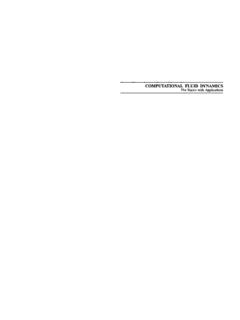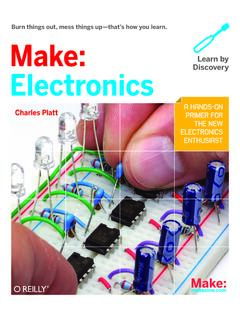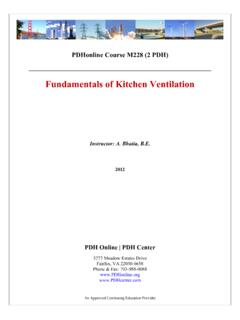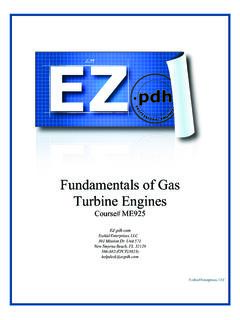Transcription of Wind PowerWind Power Fundamentals
1 Wind PowerWind Power FundamentalsFundamentalsPresented by:Alex Kalmikov and Katherine DykesWith contributions from:Kathy AraujoPhD Candidates, MIT Mechanical Engineering, Engineering Systems and Ub PliUrban PlanningMIT Wind Energy Group & Renewable Energy Projects in ActionRenewable Energy Projects in ActionEmail: History of Wind PowerHistory of Wind Power Wind Physics Basics Wind Power Fundamentals Technology OverviewTechnology Overview Beyond the Science and Technology What s underway @ MITWind Power in History ..Brief History Early SystemsHarvesting wind Power isn t exactly a new idea sailing ships, wind-mills, wind-pumps1st Wind Energy Systems Ancient Civilization in the Near East / Persia Vertical-Axis Wind-Mill: sails connected to a vertical shaft connected to a grinding stone for millingWind in the Middle AgesP t Mill I t dd i N thE Post Mill Introduced in Northern Europe Horizontal-Axis Wind-Mill.
2 Sails connected to a horizontal shaft on a tower encasing gears and axles for translating horizontal into rotational motionfor translating horizontal into rotational motionWind in 19thcentury US Wind-rose horizontal-axis water-pumping wind-mills gfound throughout rural AmericaTorrey, Volta (1976) Wind-Catchers: American Windmills of Yesterday and Tomorrow. Stephen Green Press, , Robert (1996) Wind Energy in America. University of Oklahoma Press, History -Rise of Wind Powered Electricity1888: Charles Brush builds first large-size wind electricity generation turbine (17 m diameter yg(wind rose configuration, 12 kW generator)1890s: Lewis Electric Company of New York sells generators to retro-fit onto existing wind mills1920s1950s:Pllt2&3bl d1920s-1950s: Propeller-type 2 & 3-blade horizontal-axis wind electricity conversion systems(WECS)1940s 1960s.)
3 Rural Electrification in US and Europe leads to decline in WECS useTorrey, Volta (1976) Wind-Catchers: American Windmills of Yesterday and Tomorrow. Stephen Green Press, , Robert (1996) Wind Energy in America. University of Oklahoma Press, History Modern EraKey attributes of this period: Scale increase Commercialization Competitiveness Grid integrationCatalyst for progress: OPEC Crisis (1970s) Economics Energy independence Environmental benefitsTurbine Standardization:Turbine Standardization: 3-blade Upwind Horizontal-Axis on a monopole towerSource for Graphic: Steve Connors, MIT Energy Initiativeon a monopole towerWind Physics Basics.
4 Origin of WindWind Atmospheric air in motion Energy sourceSolar radiationdifferentially bbdb th fabsorbed by earth surface converted through convective processes due to temperature differences to air motionSpatial Scalesdifferences to air motionpPlanetary scale: global circulationSynoptic scale: weather systemsMlllthiMeso scale: local topographic or thermally induced circulationsMicro scale: urban topographySource for Graphic: NASA / GSFCWind types Planetary circulations: Jet stream Trade windsPolar jets Polar jets Geostrophic winds Thermal winds Gradient winds Katabatic / Anabatic winds topographic winds Bora / Foehn / Chinook downslope wind storms Sea Breeze / Land Breeze Convective storms / Downdrafts Hurricanes/ Typhoons Tornadoes Gusts / Dust devils / Microbursts Gusts / Dust devils / Microbursts Nocturnal Jets Atmospheric WavesWind Resource Availability and VariabilitySource: Steve Connors, MIT Energy InitiativeSource for Wind Map Graphics.
5 AWS Truewind and 3 TierFundamentals of Wind Power ..Wind Power FundamentalsWind Power Fundamentals ..Fundamental Equation of Wind PowerWi d Pdd Wind Power depends on: amount of air (volume) speed of air (velocity) A mass of air (density)flowing through the area of interest (flux) Kinetic Energydefinition:Av Kinetic Energydefinition: KE = * m * v2 Power is KE per unit time:dmmd=&mass fluxPower is KE per unit time: P = * * v2 Fluid mechanics gives mass flow ratedt&m(density * volume flux): dm/dt = * A * vThus: Thus: P = * * A * v3 Power ~ cube of velocity Power ~ air density Power ~ rotor swept area A= r2 Efficiency in Extracting Wind PowerBetz Limit & Power Coefficient.
6 Power Coefficient, Cp, is the ratio of Power extracted by the turbine to the total contained in the wind resource Cp = P/Pto the total contained in the wind resource Cp = PT/PW Turbine Power outputPT= * * A * v3* CpT The Betz Limit is the maximal possible Cp = 16/27 59%efficiency is theBESTa conventional wind turbine can do in 59% efficiency is the BESTa conventional wind turbine can do in extracting Power from the windPower Curve of Wind TurbineCapacity Factor(CF): The fraction of the year the turbine generator is operating at rated (peak) powerrated (peak) Power Capacity Factor = Average Output / Peak Output 30% CF is based on both the characteristics of the turbine and the site characteristics (typically or above for a good site)Wind Frequency DistributionPower Curve of 1500 kW Turbine0.
7 060. 080. 10. 1200. 020. 04<1-2-3-4-5-6-7-8-9012345678920 Nameplate Capacity<1-2-3-4-5-6-7-8-9-110-111-112-1 13-114-115-116-117-118-119-2wind speed (m/ s)Lift and Drag ForcesWind Power Technology ..Wind TurbineAlt ll l t i lE th idd ith t bift Almost all electrical Power on Earth is produced with a turbine of some type Turbine converting rectilinear flow motion to shaft rotation through rotating airfoilsType ofCombustionPrimayElectricalGtiTPCiTurbi ne TypeGenerationTypeGas Steam Water AeroPowerConversion Traditional BoilerExternal ShaftGenerator Fluidized BedExternal ShaftGeneratorCombustion Integrated GasificationBoth ShaftGeneratorIntegrated GasificationBoth ShaftGeneratorCombined-Cycle combustion
8 TurbineInternal ShaftGeneratorCombined CycleBoth ShaftGenerator Nuclear ShaftGeneratorDiesel GensetInternalShaftGeneratorMicro-Turbin esInternal ShaftGeneratorFuel CellsDirectInverterHydropower ShaftGenerator Biomass & WTEE xternal ShaftGeneratorWindpower ShaftGeneratorPhotovoltaicsDirectInverte r Solar Thermal ShaftGenerator Geothermal ShaftGenerator Geothermal ShaftGeneratorWave Power ShaftGeneratorTidal Power ShaftGenerator Ocean Thermal ShaftGeneratorSource: Steve Connors, MIT Energy InitiativeWind Turbine TypesHorizontal-Axis HAWT Single to many blades - 2, 3 most efficient Upwind downwind facing Upwind, downwind facing Solidity / Aspect Ratio speed and torque Shrouded / Ducted Diffuser Augmented Wind Turbine (DAWT)Wind Turbine (DAWT) Vertical-Axis VAWT Darrieus / Egg-Beater (lift force driven) Savonius (drag force driven)
9 Photos courtesy of Steve Connors, MITEIWind Turbine Subsystems Foundation Tower Nacelle Hub & Rotor DrivetrainDrivetrain Gearbox Generator Electronics & ControlsElectronics & Controls Yaw Pitch Braking Braking Power Electronics CoolingDiagnostics DiagnosticsSource for Graphics: AWEA Wind Energy Basics, and Tower Evolution from truss (early 1970s) to monopole towers Many different configurations proposed for offshore Many different configurations proposed for offshoreImages from National Renewable Energy LaboratoryNacelle, Rotor & Hub Main Rotor Design Method (ideal case):1 Determine basic basic configuration: orientation and blade number2.
10 Take site wind speed and desired Power outputpower output3. Calculate rotor diameter (accounting for efficiency losses)4 Select tipspeed ratio (higher tip-speed ratio (higher more complex airfoils, noise) and blade number (higher efficiency with more blades)more blades)5. Design blade including angle of attack, lift and drag characteristics6 Combine with theory or with theory or empirical methods to determine optimum blade shapeGraphic source Wind Power : Turbine Blades Blade tip speed: 2-Blade Systems and Teetered Hubs:Teetered Hubs: PitchPitch control: Generator Generator.















